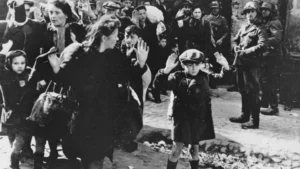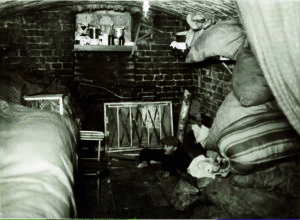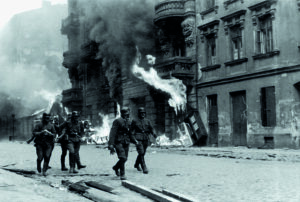Forgotten Friday – The Warsaw Ghetto Uprising
This week in our Forgotten Friday, we are focusing on The Warsaw Ghetto Uprising in 1943.
After the Grossaktion Warsaw of summer 1942, in which more than a quarter of a million Jews were deported from the ghetto to Treblinka and murdered, the remaining Jews began to build bunkers and smuggle weapons and explosives into the ghetto. The left-wing Jewish Combat Organization (ŻOB) and right-wing Jewish Military Union (ŻZW) formed and began to train. A small resistance effort to another roundup in January 1943 was partially successful and spurred Polish resistance groups to support the Jews in earnest.
On 19th April 1943, on the eve of Passover, the police and SS auxiliary forces entered the ghetto. They were planning to complete the deportation action within three days but were ambushed by Jewish insurgents firing and tossing Molotov cocktails and hand grenades from alleyways, sewers, and windows.

In this April 19, 1943 file photo, a group of Jews are escorted from the Warsaw ghetto by German soldiers. Photo From: https://www.france24.com/en/europe/20230418-the-warsaw-ghetto-uprising-an-act-of-desperate-resistance-by-polish-jews
The Germans suffered 59 casualties and their advance bogged down. Two of their combat vehicles (an armed conversion of a French-made Lorraine 37L light armoured vehicle and an armoured car) were set on fire by petrol bombs.
The Jewish fighters, armed with only a small number of weapons and homemade explosives, put up fierce resistance against the well-equipped German troops. Despite being vastly outnumbered and outgunned, they managed to hold out for nearly a month, fighting from bunkers, cellars, and other hiding places within the ghetto.
The uprising inspired hope and defiance among Jews both inside and outside the ghetto, although support from the Polish resistance and the Allies was limited. On 16th May, 1943, after weeks of intense fighting and brutal Nazi reprisals against civilians, the Germans succeeded in crushing the uprising. Most of the remaining Jewish fighters were killed, and the ghetto was razed to the ground.

2904434 Emerging & Out of Hiding (b/w photo); A Jewish Freedom Fighter emerges from his hiding place below the floor of a bunker prepared for the Warsaw ghetto uprising. Buyenlarge Archive/UIG.
Jürgen Stroop’s internal SS daily report for Friedrich Krüger, written on 16 May 1943, stated:
‘180 Jews, bandits and sub-humans, were destroyed. The former Jewish quarter of Warsaw is no longer in existence. The large-scale action was terminated at 20:15 hours by blowing up the Warsaw Synagogue. … Total number of Jews dealt with 56,065, including both Jews caught and Jews whose extermination can be proved. … Apart from 8 buildings (police barracks, hospital, and accommodations for housing working-parties) the former Ghetto is completely destroyed. Only the dividing walls are left standing where no explosions were carried out’[1]

This image shows a group of German soldiers walking down burning Nowolpie Street. This image is from the German photographic record of the event, known as the Stroop report.
13,000 Jews were killed in the ghetto during the uprising (some 6,000 among them were burnt alive or died from smoke inhalation). Of the remaining 50,000 residents, almost all were captured and shipped to the death camps of Majdanek and Treblinka.
Although the Warsaw Ghetto Uprising ended in defeat, it remains a symbol of Jewish resistance and bravery during the Holocaust. It demonstrated the indomitable spirit of those who refused to passively accept their fate and instead chose to fight for their dignity and freedom, even in the face of overwhelming odds.
The uprising It inspired other acts of resistance in ghettos and concentration camps, and its memory continues to be commemorated through memorials, literature, and film.
[1] “The Warsaw Ghetto: The Stroop Report – “The Warsaw Ghetto Is No More” (May 1943)”. Accessed 17th April, 24’

